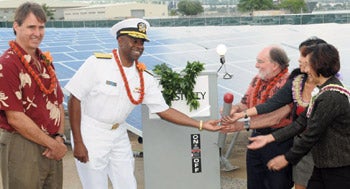 Hawaii recently topped the national rankings for energy saving initiatives for the second year in a row. In August, the Energy Services Coalition (ESC) granted the state its ‘Race to the Top’ award for modeling excellence in energy and water efficiency. ESC’s Race to the Top challenge ranks states based on investment per capita in energy savings performance contracting. Hawaii leads with $132.25 per capita, followed by Ohio with $108.58 and Kansas with $97.77. The national average hangs at a low $37.20.
Hawaii recently topped the national rankings for energy saving initiatives for the second year in a row. In August, the Energy Services Coalition (ESC) granted the state its ‘Race to the Top’ award for modeling excellence in energy and water efficiency. ESC’s Race to the Top challenge ranks states based on investment per capita in energy savings performance contracting. Hawaii leads with $132.25 per capita, followed by Ohio with $108.58 and Kansas with $97.77. The national average hangs at a low $37.20.
Hawaii sets a strong example for outstanding, innovative energy savings performance contracting. Performance contracts are commonly used for public-sector buildings, especially schools, which often cannot afford the upfront costs attributed to energy and water efficiency upgrades. Under many performance contracts, contractors pay the upfront costs and even guarantee net energy savings for the building owner. The contractor then recoups the investment through a portion of the resulting energy savings. This payment structure enables school districts and other public-sector entities to upgrade existing buildings with improved energy efficiency and without the worry of high upfront costs. To see why upgrades are so important for school buildings, see my other blog post here.
This Race to the Top award is similar to the campaign currently being debated in the U.S. Senate in that it challenges states to strive for energy efficiency gains. Additionally, the national Race to the Top legislation under consideration would award competitive grants to states for state policy and program innovations aimed at increasing efficiency into the future; ESC’s Race to the Top simply recognizes the efforts states have already realized through their own ingenuity and drive for a clean energy economy.
According to Governor Neil Abercrombie, Hawaii’s clean energy efforts will cut costs at state facilities and create several thousand jobs. And the Aloha State shows no signs of slowing down – a funding agency for renewable energy start-ups in Hawaii, the Energy Excelerator, just received $30 million from the U.S. Navy for inventive projects such as an experimental renewable energy microgrid project, a grid-connected wave power system and a rainwater harvesting system.
Hawaii is a sunny and windy state with high energy costs, which makes it a desirable market for clean technology. The U.S. Navy’s Pearl Harbor installation is a prime example of the state’s rapid transition to renewable energy. The Navy installed solar panels on five rooftops at the base, which harvest enough solar energy to power 440 homes. Hawaii is also home to the nation’s first grid-connected wave energy system. With the rise and fall of the waves in Kaneohe Bay, the Marine Corps Base is drawing electrical power from the ocean – think of this as ‘blue’ energy. Other innovative projects include sea water air conditioning, which uses cold water from the ocean to help cool several buildings across the islands, including the University of Hawaii medical school and (soon to be) forty buildings in downtown Honolulu.
In May, Hawaii passed Senate Bill 1087, which allows the state to create and issue a Green Energy Market Securitization (GEMS). This will provide low-cost financing for a variety of clean energy projects and be one of the primary lenders under an on-bill repayment (OBR) program currently under development. This program covers a wide range of property types and caters to both residential and commercial customers by financing energy efficiency and renewable energy projects through cost-saving financing from private sector investors as well as GEMS. The investments are repaid through customers’ utility bills and financed at no additional cost to ratepayers. EDF is proud to work with the Hawaiian Electric Company, the Hawaiian Public Utilities Commission, Sierra Club, Earthjustice, Blue Planet and other stakeholders to rollout the OBR program by early 2014.
Frankly, Hawaii’s progress is leaving other states in the dust.
Hawaii is saving $14.2 million and 60.9 million kilowatt hours per year through performance contracting, according to state official Richard Lim. This success goes to show that clean energy delivers quite the bang for your buck.










